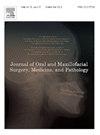Osteonecrosis of the jaw in a patient treated with alendronate and then denosumab: A case of dramatic amelioration by minocycline and then etidronate
IF 0.4
Q4 DENTISTRY, ORAL SURGERY & MEDICINE
Journal of Oral and Maxillofacial Surgery Medicine and Pathology
Pub Date : 2024-08-14
DOI:10.1016/j.ajoms.2024.07.012
引用次数: 0
Abstract
Nitrogen-containing bisphosphonates (NBPs) and denosumab are widely-used anti-bone-resorptive agents. However, osteonecrosis of the jaw (ONJ) is a known side effect with each of them (called BRONJ or DRONJ, respectively). BRONJ and DRONJ are intractable, and no sound/solid treatments have been established. Some reports note that denosumab carries a greater risk of ONJ than NBPs, and that they mutually augment the risk. Our previous animal and in vitro studies led us to suppose that etidronate (a bisphosphonate not containing nitrogen) may be effective against BRONJ, and we reported that etidronate ameliorated BRONJ in all 13 of the patients we tested. Here, we add a case in which etidronate healed stage 3 ONJ caused by alendronate (an NBP) followed by denosumab. We first treated her with minocycline (a bacteriostatic antibiotic) and then etidronate. Pain and drainage disappeared with minocycline. Within 3 weeks after the start of etidronate, bone exposure was markedly reduced and it had disappeared within 6 months, being followed by osteogenesis in the injured area and fracture-line disappearance. These results suggest that (i) in the present patient, the major cause of ONJ might have been alendronate, with denosumab possibly promoting its progress, (ii) etidronate is effective against BRONJ caused not only by NBPs, but also by NBPs + denosumab, and (iii) minocycline is suitable as a combination drug with etidronate, because in addition to its bacteriostatic effect, minocycline has various effects helping to ameliorate ONJ, including analgesic, anti-inflammatory, and bone-forming effects together with its high affinity for bone.
先用阿仑膦酸钠后用地诺单抗治疗颌骨骨坏死:米诺环素后用地诺单抗治疗显著改善的一例
含氮双膦酸盐(NBPs)和地诺单抗是广泛使用的抗骨吸收剂。然而,下颌骨坏死(ONJ)是这两种药物(分别称为BRONJ或DRONJ)的已知副作用。BRONJ和DRONJ是难治性的,没有建立声音/固体治疗方法。一些报告指出,denosumab比nbp具有更大的ONJ风险,并且它们相互增加风险。我们之前的动物和体外研究使我们假设依地膦酸盐(一种不含氮的双膦酸盐)可能对BRONJ有效,并且我们报道了依地膦酸盐在我们测试的所有13例患者中改善BRONJ。在这里,我们增加了一个病例,其中依地膦酸盐治疗由阿仑膦酸钠(一种NBP)引起的3期ONJ,然后是地诺单抗。我们首先用米诺环素(一种抑菌抗生素)治疗她,然后用地替膦酸盐。米诺环素治疗后疼痛和引流消失。依地膦酸钠开始使用后3周内,骨暴露明显减少,6个月内骨暴露消失,随后损伤部位成骨,骨折线消失。这些结果提示:(1)本例患者ONJ的主要原因可能是阿仑膦酸钠,而denosumab可能促进了ONJ的进展;(2)依地膦酸钠不仅对NBPs引起的BRONJ有效,而且对NBPs + denosumab也有效;(3)米诺环素适合与依地膦酸钠联用,因为米诺环素除了抑菌作用外,还具有多种有助于改善ONJ的作用,包括镇痛、抗炎、抗氧化、抗氧化、抗氧化、抗氧化等。和骨形成作用连同它对骨的高亲和力。
本文章由计算机程序翻译,如有差异,请以英文原文为准。
求助全文
约1分钟内获得全文
求助全文
来源期刊

Journal of Oral and Maxillofacial Surgery Medicine and Pathology
DENTISTRY, ORAL SURGERY & MEDICINE-
CiteScore
0.80
自引率
0.00%
发文量
129
审稿时长
83 days
 求助内容:
求助内容: 应助结果提醒方式:
应助结果提醒方式:


